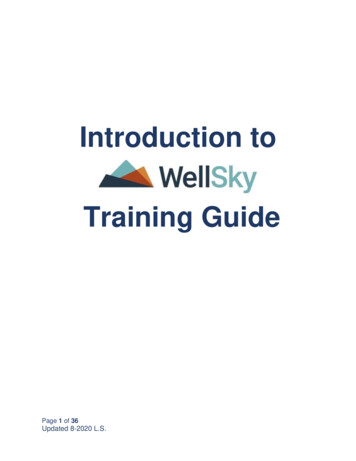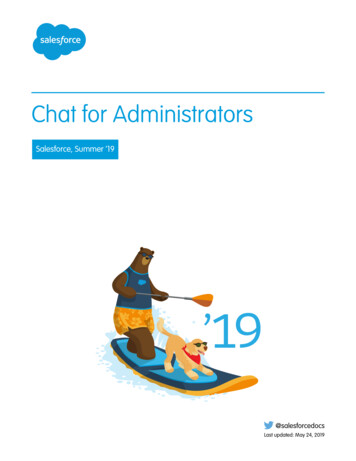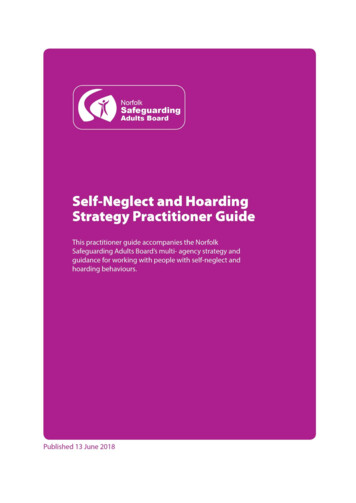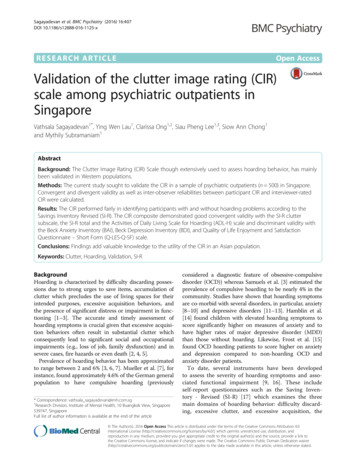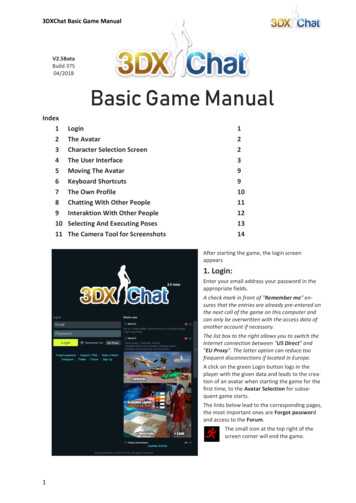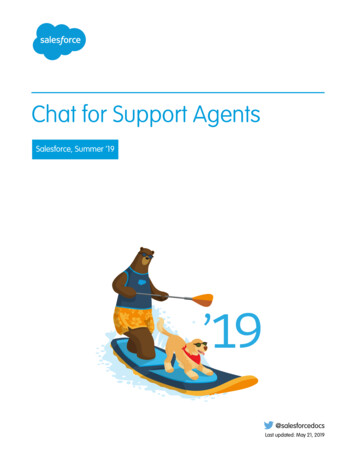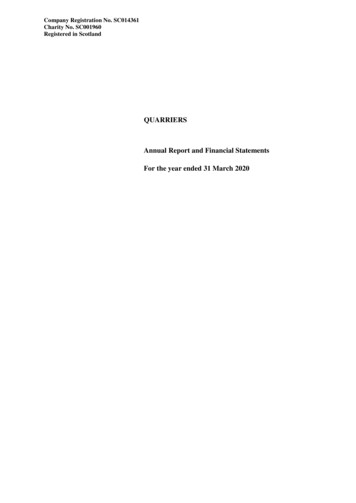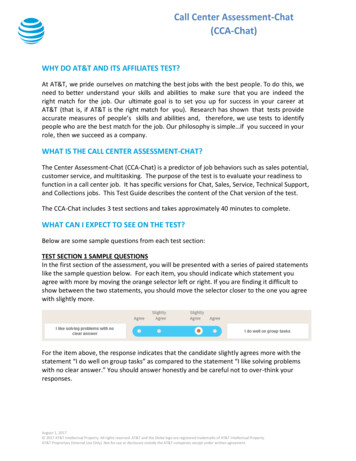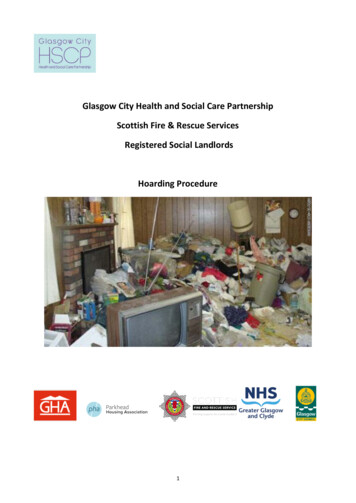
Transcription
Glasgow City Health and Social Care PartnershipScottish Fire & Rescue ServicesRegistered Social LandlordsHoarding Procedure1
IntroductionThis procedure sets out the approach to be taken by staff in Housing and Health & Social carewhen dealing with hoarding in Glasgow City Health & Social Care Partnership. The procedure alsocovers Private Rented Sector and Owner Occupied, when HSCP staff has identified the concern inthis tenure.Key Facts It is estimated that between 2 -5% of the population hoardThis equates to 1.2 million households across the UKIt is estimated that only 5% of hoarders come to the attention of the statutory agenciesHoarding can cause significant damage to the physical make up of properties and can leadto death – it is suggested that up to 25% of accidental domestic fire fatalities involvehoarded households.It is estimated that the average cost of a hoarding case from start to finish can be anythingup to 60,000.20 -30% of OCD sufferers are hoarders ( Chartered Institute of Environmental Health)Often, people who hoard can stop landlords from meeting their statutory duties – i.e. Gassafety checks and other certification requirements for Social LandlordsThis procedure note will give staff guidance in: how to identify hoarding behaviour how to assess risk and levels of hoarding case management clear action and timescales linked to the level of risk action/support plans use of legal remedies involving the statutory agencies through the multi-agency protocoland links with the HSCP 9 Health and Wellbeing Outcomes.2
Identifying HoardingSelf – neglect is the inability (intentional or unintentional) to maintain a socially and culturallyacceptable standard of self-care with the potential for serious consequences to the healthand well-being of the individual and potentially their community.Extreme self-neglect can be known as Diogenes syndrome a disorder characterised bydomestic squalor, social withdrawal, apathy, compulsive hoarding or garbage and lack of shame.Sufferers may also display symptoms of catatonia.Hoarding is the excessive collection and retention of materials to the extent that they affect day today living and create a potential hazard. The impact of hoarding can create significantmanagement problems and may require long term input and support in order to resolve effectively.It’s not the preserve of any group of people and can start at an early age but collections are likelyto grow as people age and so cases are more often seen with older people. Restrictions followingillness, accident or that increase with age also contribute to hoarding, by limiting a person’sphysical capability to take action.Hoarding is also exhibited by people who have other issues that might make them vulnerable, forexample, anxiety, depression or obsessive compulsive disorder, or it can follow on from atraumatic experience.Hoarding characteristicsHoarding is a classified mental disorder and is the excessive collection and retention of materialsto the extent that they affect day to day living and create a potential hazard. Hoarding causes anuisance or hazard to others as well as to the individual.In many cases it will be very clear that there is a problem, where rooms of full of items, but thehoarding may initially be confined to certain rooms.Indications include: acquiring and failing to throw out a large number of items that would appear to havelittle or no value to others ( e.g. papers, notes, flyers, newspapers, clothes) severe cluttering of the person’s home so that it is no longer able to function as a viableliving space reluctance of tenant to give access, missed access arrangements for repairs, safetychecks smells coming from rooms property being dirty or in disrepair overstuffed cupboards large number of pets Self neglect curtains always drawn/house looking unoccupiedStaff identifying that a tenant has a hoarding problem should also bear in mind the following points:3
Hoarding maybe an indicator of an underlying mental health problem.Hoarding increases the risk of fire in a property and can impede the rescue services wherematerials block doors and windowsIt can compromise the health and safety of neighbours and the wider community especiallywhere the tenant occupies a flat and/or where the material hoarded encourages infestationsof mice or insectsPeople with a hoarding problem can be socially isolated. They may not be used to dealingwith people in their daily lives.Be aware that hoarders are often reluctant to seek help and may even refuse it whenoffered.Be objective and do not prejudge the underlying causes. Judging a hoarder may alienatethem and make it harder for staff to work with them.Do not devalue the importance of the items hoarded or touch without the tenant’sagreement, so do not refer to them as “rubbish” as they are likely to have some personalvalue.Hoarders often see their behaviour as normal. The action plan should be solution – focusedand concentrate on tackling the problems hoarding causes – nuisance, and health andsafety of themselves and others.Do not use confrontational language when referring to the problem or the hoarder’spossessions.Animal welfare must be considered where a hoarder is keeping pets. Concerns should beraised with the SSPCA or other animal welfare organisation.The likelihood of hoarding reoccurring is quite high. Cases must be closely monitoredAny member of staff who has concerns that a tenant may be hoarding, particularly where there is ahistory of failed access or refusal to have repair/improvement works undertaken, should contactthe locality housing team by e-mail/telephone.4
The ProcessThe process as illustrated in the Process Map included at Appendix 1 provides a pathway for thekey stages from the trigger point where hoarding is first identified, through to deciding a course ofaction, and monitoring the outcome.Central to the process is a customer centric support based approach that recognises that hoardingis a mental disorder and solutions will be different for each individual.Hoarding ChecklistAppendix 2Clutter Image RatingAppendix 3Action Plan TimescalesFollowing the initial visit and assessment an Action plan should be developed that is both realisticand proportionate, tailored to the individual tenant, taking into account the following factors: The tenant’s mental or physical condition and their ability to carry out work The severity of the condition of the property The risk of serious harm or accident as a result of the condition of the property Available resources to support the tenant Need to gain the tenant’s trust and to agree small goals through a measured( softly, softly)approach to achieving resultsA pro forma for the Action Plan is included at Appendix 4 and should be developed. This shouldbe agreed with the tenant wherever possible. Actions should normally be taken in stages so as notto overwhelm or confuse the tenant where there are no pressing health and safety risks identified.These should be prioritised. For example, clearing a room to re-establish cooking and washingfacilities and perhaps storing items in an assigned room where there is a reluctance to initiallydiscard.It may be useful to use photographic prompts to help the tenant assess the level of hoarding anduse these to demonstrate progress as they work through the Action Plan.5
Developing the Action PlanUsing the Assessment Tool Guidelines, included at Appendix 5, actions should be tailored tomeet the assessed circumstances of the tenant(s). The guidance assesses hoarding on 3 levelsdepending on the degree of clutter:Level 1 (Green) Rating 1 – 3Images 1 – 3 indicate Level 1. The property is considered standard and no specialist assistancerequired unless the tenant needs help with home care or housing support. In these circumstancesthe plan should comprise of practical actions for the tenant which could include recycling ofunwanted items, getting help with the garden, additional waste bins plus signposting to otheragencies, e.g. Welfare Rights.Level 2 (Amber) Rating 4 – 6Images 4 – 6 indicate Level 2. Emerging and actual issues with the property are identified and thetenant needs some assistance to address these. It is a requirement at this level for a referral to bemade to care and support agencies, ideally with the tenant(s) consent.Level 3 (Red) Rating 7 – 9Images 7 – 9 indicate Level 3. Very real issues exist within and outwith the property. In thesecircumstances, a 24 hour safeguarding alert has to be raised with adult/child protection.The tenant should be given a copy of the Action Plan which will include what is expected of themand by when and signed by the tenant(s) unless there is a genuine reason why they cannot. Theprocess should be fully explained so that they are clear as to what to expect.Action plans are recommended to be completed for up to a 12 month period but this will depend onthe scale of hoarding. After that time a significant improvement should be seen. If not the case,and with the support of other agencies, the tenant may be considered for some form ofenforcement action.Action on defaultWhere the tenant defaults on the Action Plan, a further multi-agency case conference should beconvened.6
Support and referral to external agenciesThe priority is to engage with the tenant wherever possible but where family or friends are alreadyinvolved, we should encourage their assistance where the tenant(s) consents, and data protectionprinciples are upheld.Where the tenant is already engaging with a support service, we should work alongside thisarrangement and factor this into the Action Plan. This is important where the hoarder already hasan established relationship, as hoarders can be mistrustful of new services.Social Work ServicesAdult Care, SWS, is responsible for ensuring the most vulnerable adults in our community and theirinformal carers are safeguarded and provided with support to meet their needs. Social Care Direct is the first point of contact for Social Work services and all referralsshould be made by telephone or by e-mail Phone: 0141 287 0555 (text phone 18001 0141287 0555) Email: socialcaredirect@glasgow.gov.uk Post: Social Care Direct, Glasgow City Council. PO BOX 26845. Glasgowto this team in the first instance, but if there is a likely mental illness and concern for an individual'smental health and wellbeing, their GP should also be contacted where consent is given(Appendix4). Template letter is provided in Appendix 6. Likewise, if the risk of harm to self or others isimmediate then police should be contacted - as for any other individual.Community Mental Health Team (CMHT)Discussion with an individual’s GP prior to a decision to refer to Adult Mental Health Services ishighly recommended. This assists in the implementation of any treatment interventions that shouldbe delivered within the Primary Care context and allows for consideration of referral on to the mostappropriate Team within the Adult Mental Health Service.Only tenants diagnosed with a severe and enduring mental illness (EMI) will be accepted by theCMHT. Tenants who do not have an EMI will be referred to the Primary Care Mental Health Team.Support is also available from a number of third sector providers.Scottish Fire & Rescue ServiceA referral should also be made to the Scottish Fire and Rescue Service (SFRS) where it isbelieved that a tenant could be vulnerable to fire, for a Home Safety Check and to provide firesafety advice the prevention of fire. On the prevention of fire, contact the SFRS by following theweb address, W.GLAHFSVReferrals@firescotland.gov.uk and complete the online form.Hoarding is considered a serious issue for fire service personnel when tackling fires in domesticpremises. If the property affected by hoarding is flatted, the risk increases further not only for thefire service personnel but also for others living within the block.There is a greater risk of fire starting where the hoarding of combustible materials are stored closeto, or in contact with heat sources. Emergency access is likely to be impeded and egress may be7
restricted, slowing down escape. Poor underfoot conditions increase the risks of slips and trips anddisorientation becomes an issue for fire fighters where normal landmarks and features within aproperty are no longer obvious.In a fire situation, high fire loading (the amount and weight of combustible material) increases theseverity of the fire and increases the risk to fire fighters and the risk of it spreading to neighbouringproperties. There is also an increased risk of structural damage.Referring a hoarding case to the SFRS will allow for advice around fire prevention to be discussedwith the occupant. The service: Is free Concentrates on prevention, detection and escape Advises on specialist alarms for the hearing impairedThe SFRS can securely hold information linked to an address which can be shared with attendingcrews should a 999 call come in for that address.Welfare Rights –Scottish Welfare FundThe cost of clear and clean outs can be funded through a Scottish Welfare Fund where atenant’s financial circumstances are eligible. There is a limited pot of money so only those withthe greatest need are most likely to be given a grant. This will not be awarded for repeat casesThe Fund is “discretionary” this means that there is no right to a grant. Decisions are madebased on personal circumstances and as everyone’s circumstances are different, grantawards differ from person to person. If a tenant is awarded a grant, it does not have to be paidback. For more information or to apply SWF@glasgow.gov.uk8
Legal and other remediesLegal action will be considered but only as an absolute last resort in all cases, and after all otheravailable courses of action have been exhausted.Mental capacity and disabilityBefore taking any enforcement action, Housing Officers will need to consider whether the tenanthas mental capacity if this has not already been established. Please note that a tenant can havemental health difficulties, but still have mental capacity to understand that legal action is beingconsidered. Similarly, a person is not to be treated as unable to make a decision merely becausethey may make an unwise decision.Housing Officers should also take into account whether a tenant has a disability that would impacton the case. Officers should ensure that the tenant is receiving/has been offered the appropriatesupport and that any legal action is proportionate to achieving the desired outcome.Record KeepingIt is crucial that accurate records are kept of all actions taken, this includes (but not limited to): attempts to contact the tenant ( telephone calls and visits) details of the condition of the property ( including photographic evidence) referrals to other services action plans developed with the tenant(s) letters sent agreements madePhotographic evidence is important in all hoarding cases. The tenant should be made aware of therequirement to take photographs and that these will be stored along with other relevant documents,all marked with the date and time taken. Ideally, photographs should be taken at each visit toverify improvement actions or otherwise.9
ResponsibilitiesAll Health & Social Care staff are responsible for identifying tenancies where hoarding may beoccurring and reporting this to the relevant Housing Association. In the instance of Private rentedand Owner Occupied properties they will follow the same procedure.Housing Association (RSL) staff are responsible for identifying tenancies where hoarding may beoccurring and should ascertain if a person is known to HSCP.Scottish Fire & Rescue Service staff are responsible for identifying tenancies where hoarding maybe occurring and should ascertain if a person is known to HSCP.Cordia Staff are responsible for identifying tenancies where hoarding may be occurring and shouldascertain if a person is known to HSCP10
Contact List Scottish Fire & Rescue Service – Home Fire Safety Visit:W.GLAHFSVReferrals@firescotland.gov.uk 0141 553 4376, 0141 553 4777 SAMH (Scottish Association for Mental Health)Tel: 0141 530 1000 / Email: enquire@samh.org.uk Life – Pod CIC who work with the people to address the issues behind the hoardingfor around 8 weeks at a cost of approx. 120 per half day session per weekTel: 07421 329380Email: linda@life-pod.co.uk SSPCATel: 03000 999 999 (Option asgow.gov.uk11
APPENDICESAppendix 1 – Hoarding Process MapAppendix 2 – Hoarding Check ListAppendix 3 – Clutter Image Rating ScaleAppendix 4 – Action PlanAppendix 5 – Assessment Tool GuidelinesAppendix 6 – Referral to Social Care DirectAppendix 7 – Working Group Members12
Appendix 1Process MapsHousing Assocaition/HSCP/Cordia StaffHoarding Identified by Housing OfficerClutter Rating to be completed by HousingOfficerReferral Made to Housing & Homeless Lead (HHL)to ascertain if Tenant is knownConsent obtained to have Home Fire Safety VisitIf known HHL will notify Care Manager andrequest they contact the Housing OfficerIf not known referral to be made to SocialCare Direct for assessmentMulti-agency meeting to be organised by theCare Manager to plan way forward/ completeaction planSCD to send referral to local team13
HSCP Staff/Cordia StaffHoarding Identified by HSCP StaffClutter Rating to be completedHSCP staff member contact HHL to identify Housing AssociationIf private let or Owner OccupierIf Housing AssociationConsent obtained to have HomeFire Safety VisitConsent obtained to have HomeFire Safety VisitHHL contact relevant HousingAssociationMulti-agency meeting to be called by Care Manager14
Appendix 2Hoarding ChecklistBackgroundTenant name(s):Address:Tenant age(s)Type of Tenancy:Property type:Housing Officer:Date report received:Reason for report:Vulnerabilities/alerts:Contacts Made:Tenant(s) gender:Start date:Number of bedrooms:Reported by:Housing Officers should use the following checklist to determine whether the condition of theproperty or garden meets the threshold to be categorised as hoarding.In doing so, consideration should be given to whether rooms can be used for their purpose and ifthere are any health and safety concerns.Housing Officer/HSCP Staff member to complete:Hoarding detailsTypes of items:Food itemsAnimalsCD’s/videosClothingLetters/billsMain rical itemsBooksPackagingBoxes/bagsGeneralrubbishOther ( pleasestate)15ExcrementFurniture
RoomChecks on the propertyCan the room be Are there any healthused for itsand safetypurpose?concerns?YesNoYesNoClutter rating1-3123KitchenBathroomRoomCan the roombe used for itspurpose?YesNoAre there any healthand safety concerns?YesNoSeparate w.c( if appropriate)LoungeBedroom 1Bedroom 2Bedroom 3Dining room(if appropriate)Access from thefront door16Clutter rating1-3123
RoomCan the room beused for itspurpose?YesNoAre there any healthand safetyconcerns?YesNoAccess from theback doorStairs(if appropriate)Loft space(only wherespecificconcerns havebeen raised)GardenShed/outhouse17Clutter rating1-3123
Additional informationAny imminent fire risks? Consider: flammablematerials, working smoke alarms, any evidence ofprevious fire/smoke damage e.g. candlesAre there pet/pest control issues?Is hoarding spilling over into the garden/communal areas?Is there an overuse of electric extensioncables?Any apparent repair issues to address?e.g. mould growth, leaks electrical etc.Do the occupants smoke?Do the occupants have known alcohol orsubstance misuse issues?What type of heating is in the property?Does the tenant use portable heaters?Is the tenant(s) receiving housing supportor known to any external agency e.g.Wellbeing?Name of HousingOfficer completingthe form:Date:18
Appendix 3Clutter Image Rating Scale (CIRS)1The purpose of this tool is to gauge the impact of hoarding on the person with the hoarding behaviour.Clutter Image Rating Scale: Part 1 of 3 – KitchenPlease select the photo below that most accurately reflects the amount of clutter in your room.1234567891 Source: Frost RO, Steketee G 2006a, Compulsive Hoarding and Acquiring: Therapist Guide. New York.Oxford University Press. The Clutter Image Rating (CIR) Tool, p. 188. Used with permission of OxfordUniversity Press, USA.19
Clutter Image Rating Scale: Part 2 of 3 – BedroomPlease select the photo below that most accurately reflects the amount of clutter in your room.12345678920
Clutter Image Rating Scale: Part 3 of 3 – Living roomPlease select the photo below that most accurately reflects the amount of clutter in your room.12345678921
Appendix 4Hoarding Action PlanTo be agreed with tenantTenant detailsAddress:Name:Tel NoHousing Association:Housing Officer:Agreed actionsTarget date forcompletionBy whom?Progress updateReferrals to support/ other agenciesAgencyDrug & AlcoholMental HealthMediationGPOther - SpecifyYes No DateAgencyScottish Fire & RescueServiceEnvironmental ServicesAdult Care/ProtectionChild ProtectionAnimal WelfareYes No DateConsent to information sharingI consent to agencies obtaining and sharing information as part of the multi agency work to helpand secure my safety and that of my family/neighbours. If there are child protection or animalwelfare concerns, information will be shared regardless of whether this form is signed.I also consent to following the actions in this Action Plan.Signed Print Name: .Date .Appendix 5Assessment Tool Guidelines22
Level 1 CharacteristicsLevel 1 Clutter Image Rating 1 -31. Property structure, services andgarden area2. Household function3. Health and Safety4. Safeguard of Children and Familymembers5. Animals and Pests6. Personal Protective Equipment (PPE)Household environment is considered standard. Nospecialised assistance needed. Appropriate referralscan be made if the tenant requires some assistancewith home care or housing support subject to age andcircumstances All entrances and exits, stairways, roof spaceand windows accessible Smoke alarms fitted and functional otherwiserefer to Repairs Call Centre. All services functional and in good working order Garden is accessible, tidy and maintained. No excessive clutter, all rooms can be safelyused for their intended purpose All rooms rated 0 – 3 on the Clutter Rating Scale No additional unused household appliancesappear in the property Property is maintained to the council’sstandards Property is clean with no odours ( pet or other) No rotting food No concerns about candles No concerns about flies Tenant (s) manages personal care/may requiresome assistance for health reasons No concerns for household members Any pets are well cared for.No pests or infestations at the propertyNo PPE required23
Level 1: Multi Agency ActionsLevel 11. Housing2. Animal Welfare3. Safeguard of Children & FamilyMembers4. Scottish Fire and RescueActions Discuss concerns with the tenant(s) and developan Action Plan Provide advice and assistance if required withgardening, refuse services e.g. gardenmaintenance scheme, extra recycling bins, upliftof unwanted items Identify any care /support needs and refer toAdult Care for a care and support assessment ifappropriate and agreed by the tenant ( if notalready a client) Issue a request to Scottish Fire and Rescue for aHome Safety Check and to provide fire safetyadvice Income maximisation check and referral toWelfare Rights if appropriate No action unless advice requestedNo action unless concerns raised. Carry out home visit and share outcome withHousing24
Level Two CharacteristicsLevel 2Clutter Image Rating 4 - 61. Property structure, services andgarden area2. Household function3. Health and Safety4. Safeguard of Children & FamilyMembers5. Personal Protective Equipment(PPE)Household environment requires assistance to resolve theclutter and the maintenance issues in the property. Only major exit is blocked Concerns that services are not well maintained Smoke alarms are not installed or not working Garden is not accessible due to clutter, or is notmaintained Evidence of indoor items stored outside Evidence of light structural damage including damp Interior doors missing or blocked open Clutter is causing congestion in the living spaces andis impacting on the use of the rooms for theirintended purpose Clutter is causing congestion between the rooms andentrances Room(s) score between 4 – 6 on the clutter scale Inconsistent levels of housekeeping throughout theproperty Some household appliances are not functioningproperly and there may be additional units in unusualplaces Property is not maintained to the council’s standards Evidence of outdoor items being stored inside Kitchen and bathroom are difficult to utilise andaccess Offensive odour in the property Tenant is not maintaining a safe cookingenvironment Some concern with the quantity of medication, or it’sstorage/expiry dates Tenant trying to manage personal care but struggling Tenant has good fire safety awareness with little riskof ignition No risk to structure of the property Properties with adults/children presenting care andsupport needs should be referred to Adult/Childprotection Is PPE required? Latex gloves, boots or needle stick safe shoes, facemask, hand sanitizer, insect repellentLevel Two: Multi Agency Actions25
Level 21.HousingActionsIn addition to the action below listed, these cases need tobe monitored regularly due to the risk of escalation Issue a request to Scottish Fire and Rescue Servicefor a Home Safety Check and to assess for monitoredsmoke alarms/assistive technology Provide advice and assistance with gardening, refuseservices e.g. garden maintenance scheme, extrarecycling bins, uplift of unwanted items Referral to Adult/Child protection/GP if consentgiven Referral to GP/Wellbeing Support Services if notalready known. Income maximisation check and referral to WelfareRights if appropriate Referral to SSPCA if animals at the property Hold a multi-agency meeting and adopt acollaborative approach .Share relevant informationwith necessary statutory services/agencies to ensurea sustainable solution2. Scottish Fire and RescueService Carry out a Home Safety Check and assess formonitored smoke alarms/assistive technology3. Animal Welfare Visit property to undertake a wellbeing check on theanimalsEducate tenant regarding animal welfare ifappropriateProvide advice/assistance with rehoming animalsInvestigations into concerns raised about adult/childprotectionLatex gloves, boots or needle stick safe shoes, facemask, hand sanitiser, insect repellent 4. Safeguard of Children &Family members5. Personal ProtectiveEquipment (PPE) Level Three CharacteristicsLevel 3Clutter Image Rating7-9Household environment will require intervention with acollaborative multi agency approach, and the involvementof a wide range of professionals. This level of hoardingconstitutes a Safeguarding alert due to the significant riskto health of the householders, surrounding properties and26
1. Property structure, servicesand garden area2. Household functionsresidents. Limited access to the property due to extremeclutter Extreme clutter may be seen at windows Extreme clutter may be seen outside the property Garden not accessible and extensively overgrown Services not connected or functioning properly Property lacks ventilation due to clutter Evidence of structural damage or outstandingrepairs including damp Interior doors missing or blocked open Evidence of indoor items stored outside Clutter is obstructing the living spaces and ispreventing the use of the rooms for their intendedpurpose Room(s) scores 7 – 9 on the clutter image scale. Beds inaccessible or unusable due to clutter orinfestation Entrances, hallways and stairs blocked or difficult topass Toilets, sinks not functioning or not in use Tenant at risk due to living environment Household appliances not functioning orinaccessible Tenant has no safe cooking environment Tenant is using candles Evidence of outdoor clutter being stored indoors No evidence of housekeeping being undertaken Broken household items not discarded e.g. brokenglass Property is not maintained to the Council’sstandard27
Level 3Clutter Image Rating7-93. Health and Safety4. Safeguard of Children &Family members5. Animals and Pests6. Personal ProtectiveEquipment (PPE)Household environment will require intervention with acollaborative multi agency approach, and the involvementof a wide range of professionals. This level of hoardingconstitutes a Safeguarding alert due to the significant riskto health of the householders, surrounding properties andresidents. Human urine and excrement may be present Excessive odour in the property may also beevident from the outside Rotting food may be present Evidence may be seen of unclean, unused and /orburied plates & dishes Broken household items not discarded e.g. brokenglass or plates Inappropriate quantities of medication Concern with the integrity of the electrics Inappropriate use of electrical extension cables orevidence of unqualified works to electrics Concern for declining mental health Concerns about impact of hoarding on children andvulnerable adults Animals at the property at risk due to the level ofclutter in the property Tenant may not be able to control the animals Animals living area is not maintained and smells Animals appear to be under nourished or over fed Hoarding of animals at the property Heavy insect infestation (bed bugs, lice, fleas,cockroaches, ants, silverfish etc.) Visible rodent infestationLatex gloves, boots or needle stick safe shoes, face mask,hand sanitiser, insect repellentJ
Hoarding is also exhibited by people who have other issues that might make them vulnerable, for example, anxiety, depression or obsessive compulsive disorder, or it can follow on from a traumatic experience. Hoarding characteristics . Hoarding is a classified mental disorder and is the excessive collection and retention of materials
